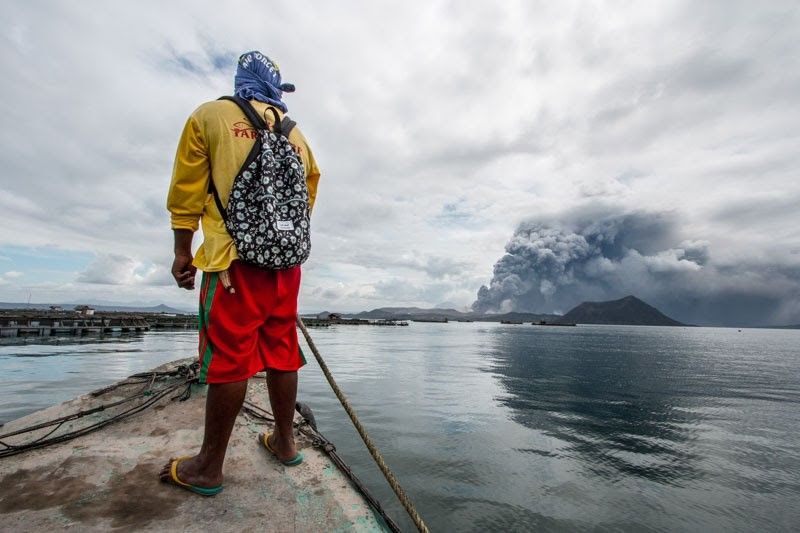Phivolcs raises Taal Volcano's alert status to level 2

MANILA, Philippines — State volcanologists on Tuesday raised the status of Taal Volcano in Batangas to Alert Level 2, saying it has been exhibiting “increasing unrest.”
In an advisory, Phivolcs said the raising of the alert level means “there is probable magmatic activity that may or may not lead to an eruption.”
With Alert Level 2 hoisted over Taal Volcano, the institute stressed that entry into Taal Volcano Island—a permanent danger zone—remains strictly prohibited. Evacuation, however, is not yet recommended.
“Local government units are advised to continuously assess previously evacuated barangays around Taal Lake for damages and road accessibilities and to strengthen preparedness, contingency, and communication measures in case of renewed unrest,” Phivolcs said.
“Residents of these barangays are advised to be always prepared, to keep calm and listen to informational only from trusted or verified sources,” it added.
Increased activity
Phivolcs said the total number of volcanic tremor events has increased to 866 since the onset of increased activity on February 13. There were also 141 low-frequency volcanic earthquakes that occurred within the volcano island and immediate vicinities.
In the past 24 hours, 28 volcanic tremor episodes, four low frequency volcanic earthquakes and one hybrid earthquake at shallow depths were recorded.
Volcanic tremors also have increased seismic energy compared to previously recorded episodes and ranged between three and 17 minutes in duration.
“Overall, seismic activity in the past month indicates increased magmatic and hydrothermal activity at shallow depths beneath TVI,” it said.
There were also changes in the main crater lake, such as recording a temperature high of 74.6°C and increase in acidity to pH 1.59 from a pH of 2.79 in January 2020.
Phivolcs explained that increasing acidity is due to the “sustained volcanic gas input into the shallow hydrothermal system that feeds into the lake, signifying degassing of magma intruded at depth during the January 2020 eruption.”
The institute also observed a “very slow but steady inflation and/or expansion of the Taal region since the end of the 2020 eruption, at very much slower stabilized rates compared to deformation before and right after eruption.”
Microgravity changes across the Taal caldera were also recorded.
Taal woke up from its decades-long slumber in Jan. 12, 2020, unleashing kilometers-high ash column and lava fountain the next day. The restive activity led to the evacuation of thousands living on the volcano island and high-risk areas, and destruction of houses and establishments in Batangas.
A year after the eruption, hundreds of displaced families are still seeking temporary shelters in evacuation centers.
Get updates as Phivolcs issues warnings over activity in Taal Volcano. (Main photo by Philstar.com/Rosette Adel)
The Philippine Institute of Volcanology and Seismology issues a notice reporting an increased and continuous degassing activity from Taal Volcano.
In its 6 p.m. advisory, Phivolcs says the sulfur dioxide emission from the main crater reached 9762 tonnes per day. This was the higher recorded this year.
Phivolcs adds that there was no smog or vog observed. — Rosette Adel
The Philippine Institute of Volcanology and Seismology says Taal Volcano is still under Alert Level 1.
In an update on Wednesday, its says that the daily sulfur dioxide emissions (SO2) reached 2887 tonnes / day (06 October 2023).
Phivolcs also observes upwelling of hot volcanic fluids in the Main Crater Lake. — Rosette Adel
The Philippine Institute of Volcanology and Seismology reports that Taal Volcano's daily sulfur dioxide emissions (SO2) reached 2887 tonnes.
It observes upwelling of hot volcanic fluids in the Main Crater Lake as well as volcanic smog or vog.
The volcano's emissions are also 2400 meters tall. — Rosette Adel
The Philippine Institute of Volcanology and Seismology releases time-lapse snapshots of degassing activity from the Taal Main Crater and volcanic smog or vog formation on Sunday.
These were taken from 5:45 a.m. to 11:42 a.m. by the Mt. Macolot, Cuenca, Batangas station (VTCU) IP Camera.
LOOK: Time-lapse snapshots of degassing activity from the Taal Main Crater and volcanic smog or vog formation taken from 05:45 AM to 11:42 AM today, 8 October 2023 by the Mt. Macolot, Cuenca, Batangas station (VTCU) IP Camera. pic.twitter.com/jp48R1IZQy
— PHIVOLCS-DOST (@phivolcs_dost) October 8, 2023
— Rosette Adel
The Philippine Institute of Volcanology and Seismology records daily sulfur dioxide emissions that reached 2730 tonnes / day (22 September 2023).
It also observes upwelling of hot volcanic fluids in the Main Crater Lake and observed VOG.
Phivolcs adds that there is a ong-term deflation of the Taal Caldera; short-term inflation of the northern flanks of the Taal Volcano Island.
- Latest
- Trending

































